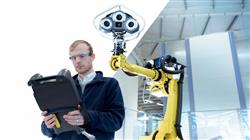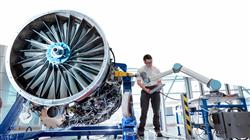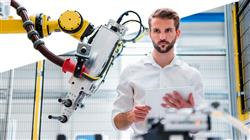University certificate
The world's largest faculty of information technology”
Introduction to the Program
A program with a theoretical-practical approach of great application in the Robotics field. Enroll now”

The advancement of technology has led to a significant increase in Augmented and Virtual Reality in recent years, as well as the interaction that humans can have with machines. A progression that will be studied in depth in this Postgraduate certificate through innovative multimedia content provided by a teaching team specialized in the field of Robotics.
A 100% online program that will allow students for 6 weeks to acquire advanced knowledge in the main techniques and tools used in computer vision, image synthesis, applying the main mathematical models of robots to the physical engines found in Virtual Reality tools.
A program that provides the most updated teaching material to which you can access the latest developments in the development of natural language and development of mechanisms of interaction between humans and robots. A program designed for students to reach quotas of improvement in their career while combining their work and/or personal responsibilities with quality education. The student only needs an electronic device with internet connection to access the syllabus, wherever and whenever they wish An opportunity to progress with a program that uses the Relearning system, which will allow you to reduce long hours of study and acquire a solid learning in a more natural way.
Advance in your career with the most updated learning in robot dynamics and kinematics modeling”
This Postgraduate certificate in Human-Machine Interaction Systems contains the most complete and up-to-date program on the market. The most important features include:
- Development of case studies presented by experts in robotic engineering
- The graphic, schematic, and practical contents with which they are created, provide scientific and practical information on the disciplines that are essential for professional practice
- Practical exercises where self-assessment can be used to improve learning
- Its special emphasis on innovative methodologies
- Theoretical lessons, questions to the expert, debate forums on controversial topics, and individual reflection assignments
- Content that is accessible from any fixed or portable device with an Internet connection
The Robotics sector is growing, take advantage of this opportunity and add another step in your career”
The program’s teaching staff includes professionals from the sector who contribute their work experience to this educational program, as well as renowned specialists from leading societies and prestigious universities.
Its multimedia content, developed with the latest educational technology, will provide the professional with situated and contextual learning, i.e., a simulated environment that will provide an immersive education programmed to learn in real situations.
The design of this program focuses on Problem-Based Learning, by means of which the professionals must try to solve the different professional practice situations that are presented throughout the program. For this purpose, students will be assisted by an innovative interactive video system developed by renowned experts.
TECH brings you the Relearning learning system, which will allow you to reduce long hours of study"

Enroll now and acquire the most updated knowledge in the improvement of expressiveness in robots"
Syllabus
The syllabus of this program has been prepared following the strict guidelines of the teaching team. Thus, students taking this program will have at their disposal video summaries, specialized readings and real case studies in the two modules into which this syllabus has been divided. In the first module, the IT professionals will learn the most advanced knowledge in the field of Augmented, Virtual and Mixed Reality applied to Robotics; in the second module, they will learn about Robot Communication and Interaction Systems. Thanks to the flexibility that TECH grants to all its programs, students will be able to access the complete syllabus of this program from the first day, distributing the course load according to their needs.

A Postgraduate certificate in which you will be able to delve into Immersive Technologies in Robotics”
Module 1. Application to Robotics of Virtual and Augmented Reality Technologies
1.1. Immersive Technologies in Robotics
1.1.1. Virtual Reality in Robotics
1.1.2. Augmented Reality in Robotics
1.1.3. Mixed Reality in Robotics
1.1.4. Difference between Realities
1.2. Construction of Virtual Environments
1.2.1. Materials and Textures
1.2.2. Lighting
1.2.3. Virtual Sound and Smell
1.3. Robot Modeling in Virtual Environments
1.3.1. Geometric Modeling
1.3.2. Physical Modeling
1.3.3. Model Standardization
1.4. Modeling of Robot Dynamics and Kinematics Virtual Physical Engines
1.4.1. Physical Motors. Typology
1.4.2. Configuration of a Physical Engine
1.4.3. Physical Motors in the Industry
1.5. Platforms, Peripherals and Tools Most Commonly Used in Virtual Reality
1.5.1. Virtual Reality Viewers
1.5.2. Interaction Peripherals
1.5.3. Virtual Sensors
1.6. Augmented Reality Systems
1.6.1. Insertion of Virtual Elements into Reality
1.6.2. Types of Visual Markers
1.6.3. Augmented Reality Technologies
1.7. Metaverse: Virtual Environments of Intelligent Agents and People
1.7.1. Avatar Creation
1.7.2. Intelligent Agents in Virtual Environments
1.7.3. Construction of Multi-User Environments for VR/AR
1.8. Creation of Virtual Reality Projects for Robotics
1.8.1. Phases of Development of a Virtual Reality Project
1.8.2. Deployment of Virtual Reality Systems
1.8.3. Virtual Reality Resources
1.9. Creating Augmented Reality Projects for Robotics
1.9.1. Phases of Development of an Augmented Reality Project
1.9.2. Deployment of Augmented Reality Projects
1.9.3. Augmented Reality Resources
1.10. Robot Teleoperation with Mobile Devices
1.10.1. Mixed Reality on Mobile Devices
1.10.2. Immersive Systems using Mobile Device Sensors
1.10.3. Examples of Mobile Projects
Module 2. Robot Communication and Interaction Systems
2.1. Speech Recognition: Stochastic Systems
2.1.1. Acoustic Speech Modeling
2.1.2. Hidden Markov Models
2.1.3. Linguistic Speech Modeling: N-Grams, BNF Grammars
2.2. Speech Recognition. Deep Learning
2.2.1. Deep Neural Networks
2.2.2. Recurrent Neural Networks
2.2.3. LSTM Cells
2.3. Speech Recognition: Prosody and Environmental Effects
2.3.1. Ambient Noise
2.3.2. Multi-Speaker Recognition
2.3.3. Speech Pathologies
2.4. Natural Language Understanding: Heuristic and Probabilistic Systems
2.4.1. Syntactic-Semantic Analysis: Linguistic Rules
2.4.2. Comprehension Based on Heuristic Rules
2.4.3. Probabilistic Systems: Logistic Regression and SVM
2.4.4. Understanding Based on Neural Networks
2.5. Dialog Management: Heuristic/Probabilistic Strategies
2.5.1. Interlocutor’s Intention
2.5.2. Template-Based Dialog
2.5.3. Stochastic Dialog Management: Bayesian Networks
2.6. Dialog Management: Advanced Strategies
2.6.1. Reinforcement-Based Learning Systems
2.6.2. Neural Network-Based Systems
2.6.3. From Speech to Intention in a Single Network
2.7. Response Generation and Speech Synthesis
2.7.1. Response Generation: From Idea to Coherent Text
2.7.2. Speech Synthesis by Concatenation
2.7.3. Stochastic Speech Synthesis
2.8. Dialog Adaptation and Contextualization
2.8.1. Dialog Initiative
2.8.2. Adaptation to the Speaker
2.8.3. Adaptation to the Context of the Dialogue
2.9. Robots and Social Interactions: Emotion Recognition, Synthesis and Expression
2.9.1. Artificial Voice Paradigms: Robotic Voice and Natural Voice
2.9.2. Emotion Recognition and Sentiment Analysis
2.9.3. Emotional Voice Synthesis
2.10. Robots and Social Interactions: Advanced Multimodal Interfaces
2.10.1. Combination of Vocal and Tactile Interfaces
2.10.2. Sign Language Recognition and Translation
2.10.3. Visual Avatars: Voice to Sign Language Translation

Enroll now and learn about the latest advances in Deep Learning”
Postgraduate Certificate in Human-Machine Interaction Systems
In today's digital world, effective human-machine interaction is a vital necessity in all fields of life, be it education, medicine, communication, gaming and more. At TECH Global University we have designed our Postgraduate Certificate in Human-Machine Interaction Systems to provide a comprehensive and up-to-date education on this critical topic. This course provides theoretical and practical training in the design, development and assessment of human-machine interaction systems. In this course, students will explore how to design effective user interfaces that meet the needs and desires of users, and how to assess the quality of these interfaces using different user experience evaluation techniques.
The Postgraduate Certificate in Human-Machine Interaction Systems provides a comprehensive and up-to-date education in this critical topic.
The Postgraduate Certificate in Human-Machine Interaction Systems focuses on providing students with a solid understanding of the fundamental concepts of human-machine interaction and how these are applied in practice. The course also covers the latest trends and advances in the field of human-machine interaction, including artificial intelligence, virtual and augmented reality, and voice-based interaction systems. This program is designed to prepare students for careers in areas such as user experience, interface design, software engineering and human-machine interaction research. If you are looking for a comprehensive and up-to-date education in human-machine interaction systems, our Postgraduate Certificate is the perfect choice for you!







